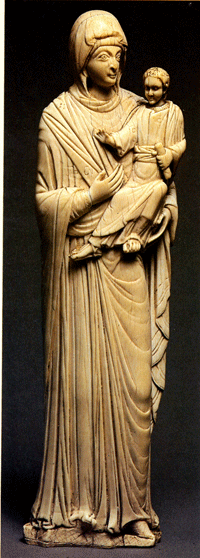 Readers may remember that I have posted a couple of pieces recently featuring sacred images from the Russia that are statues (not relief carving, full 3-D images). As I mentioned, I had been under the impression that although they were not forbidden, that by tradition they were not produced and was surprised that the examples shown existed. I suggested that the reason they were discouraged was because it is difficult to produce a three-dimensional image that is consistent with the theology of sacred images as applied to the icon (for example, the deliberated elimination of space to suggest the heavenly realm). But I couldn't give much more information about their existence and place in the tradition of the Eastern Church.
Readers may remember that I have posted a couple of pieces recently featuring sacred images from the Russia that are statues (not relief carving, full 3-D images). As I mentioned, I had been under the impression that although they were not forbidden, that by tradition they were not produced and was surprised that the examples shown existed. I suggested that the reason they were discouraged was because it is difficult to produce a three-dimensional image that is consistent with the theology of sacred images as applied to the icon (for example, the deliberated elimination of space to suggest the heavenly realm). But I couldn't give much more information about their existence and place in the tradition of the Eastern Church.
I was happy to receive responses from two Orthodox Christians in regard to the attitude to statues in the East which are helpful, I think, and I reproduce them here.
The first is from Bishop Jerome, Bishop of Manhattan of the Russian Orthodox Church Outside Russia and this seems to summarise the situation nicely. He says: "The reason that statues are avoided in the Orthodox Church (and in some of the Eastern Catholic Churches) is not that they were seen as "heretical", but as part of the struggle to overcome the iconoclasts. Prior to the iconoclastic controversy, there were bas-relief representations of holy figures in the East, and in Russia the iconoclasts seem not to have been as virulent as they were in Constantinople. Three-dimensional figures were used to some extent again in Russia in certain places, such as the cathedral of the Ss. Peter & Paul Fortress in St. Petersburg, here the Royal Gates were topped by a small statue, or in the dome of St.Isaac's cathedral where there are statues of Angels."
 The second made reference to an article published in a magazine published by an Orthodox church in Texas, Ember Tidings about statues in the Eastern Church, here (h/t Fr Anthony). This gives some history of the creation of statues, reinforcing the summary of the situation given above by Fr Jerome. It closes with the following point: 'The 1920’s discovered the Orthodox painted icon, the 1970’s the Orthodox statues. It appears the sometimes heated "two dimensional vs. three dimensional image" argument could be another example of culture intruding upon the faith.'
The second made reference to an article published in a magazine published by an Orthodox church in Texas, Ember Tidings about statues in the Eastern Church, here (h/t Fr Anthony). This gives some history of the creation of statues, reinforcing the summary of the situation given above by Fr Jerome. It closes with the following point: 'The 1920’s discovered the Orthodox painted icon, the 1970’s the Orthodox statues. It appears the sometimes heated "two dimensional vs. three dimensional image" argument could be another example of culture intruding upon the faith.'
This second article brings up a couple of interesting thoughts. First, some of the examples that are shown in the pictures are of statues East and West. This shows clearly that the tradition of statues was well established early on and not always a minor part of the sacred imagery as it became later in the Eastern Church. It also reinforces one of the points made above. It does seem to me that a strict application of the theology of the icon as I have been taught it, would mitigate against the production of three-dimensional images. But the existence of a strong tradition of statues raises this question in my mind: if the statue which by its nature occupies three-dimensional space is permitted, does this mean that there ought to be greater freedom in 2-D images that create the illusion of space? Has anyone thought about this at all I wonder? Perhaps one could, for example, make the distinction between real 3-D space and illusional space critical in permitting statues?
Pictures from top: the Good Shepherd, 3rd century from the catacombs; 10th century Contantinople; Our Lady of Monserrat, Spain, 12th century.


